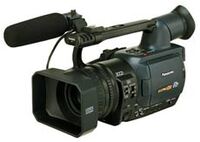Sync playbacks can be even more complicated in terms of playback rates depending on what medium is being used for the shoot compared to what medium is being used for editing & final release.
 High Def Video cameras run at 23.976, but the video is converted for editing to conventional 29.97 NTSC rate. It works out technically that if a 3-2 pulldown is applied to 23.976, which happens either in the camera or in the editing software, you end up with regular 29.97 NTSC. There is no 0.1% speed change in the process, so audio can be recorded (and played back) in regular 29.97.
High Def Video cameras run at 23.976, but the video is converted for editing to conventional 29.97 NTSC rate. It works out technically that if a 3-2 pulldown is applied to 23.976, which happens either in the camera or in the editing software, you end up with regular 29.97 NTSC. There is no 0.1% speed change in the process, so audio can be recorded (and played back) in regular 29.97.
Some video camcorders claim to shoot at 24 frame Progressive or 30 frame Progressive. The Progressive term refers to exposing all of the pixels in the frame in one blast, rather than scanning it in line by line the way normal video does. Also, in normal video, each frame is actually scanned in two passes (known as fields). That is why video looks so “live” and fluid. But Progressive captures each field in one shot, and then interpolates the data to fill in the second field of the frame. That gives it the “film look”.
The so-called 30P rate is actually 29.97. For the purposes of audio, treat it the same as regular 29.97 NTSC video.
However, 24P is not actually running at 24 frames per second, like a film camera. Instead, it is going at 23.976 (just shy of 24 fps). The 3-2 pulldown comes into play, and what comes out of the camcorder is actually 29.97 NTSC video (just that the frames/fields are sharper, and every 4th frame is repeated). All of this takes place in real time, so there is no 0.1% speed change taking place. Just use the 29.97 rate for audio, whether it is live recording or sync playback of music tracks.
Some motion picture cameras may run at 30 frame rather than 24, or even at 23.976 or 29.97. If that is the case, then treat 30fps film the same way you would 24fps, which is to record (or playback) your audio at 30 frame SMPTE, to allow for the 0.1% speed change. A sync playback tape would be prepared at 29.97, with intent to playback on the set at 30. Live dialogue would be recorded on the set at 30, with intent to transfer into video at 29.97.
Film cameras running at 23.98 or 29.97 would NOT require a speed change in their conversion to video; so all of your audio would remain in real time at 29.97.
Note that shooting with the really elaborate High Def video cameras used by Hollywood can get complex, due to the fact that to record matching timecode on the video to match the timecode on the audio involves “jam syncing with tri-level sync” in order to get all of the numbers to match precisely. If this sounds a bit over your head, it should. Don’t worry about it, though. By the time you are at that level in production, you will have access to a lot of highly paid technical folk to help you through it.
This article is only meant as a simple introduction; and is geared for beginning filmmakers.
The short version of this tutorial is to use 29.97 fps timecode for video, whether it be regular NTSC, 30P/24P “film look”, or prosumer High Def video.
When shooting actual 24fps or 30fps motion picture, then you have to deal with the 0.1% speed change, so keep your audio at 30fps timecode. Live dialog will end up being slowed down to 29.97 during transfer to video; but sync playbacks will be speeded up from their original 29.97 to 30 fps when played back on the set.
If you will be shooting your music video with anything other than conventional 24 frame film or 29.97 frame NTSC video, then double check with the film lab and video editing facility for advice on what frame rates to use for sync playback. And get the instructions in writing, signed off, so that fingers can’t be pointed at you later on in the event that you were given incorrect information!
